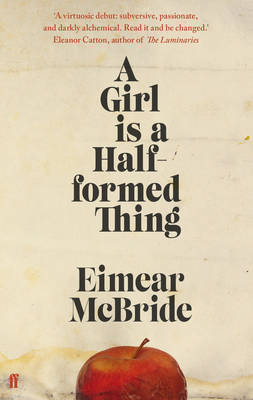Eimear McBride, A Girl is a Half-formed Thing (2013)
 This is the latest example of a small press title breaking through: A Girl is a Half-formed Thing was published last year by Norwich’s Galley Beggar Press; it has since won the inaugural Goldsmiths Prize (awarded to “fiction that breaks the mould or opens up new possibilities for the novel form”), been shortlisted for the Baileys Prize and longlisted for the Desmond Elliott Prize (which is the context in which I’m now reading it). It has also now been published in a new edition by Faber & Faber, which comes with a cover quote from Eleanor Catton. That’s apposite: both Catton and Eimear McBride have debuted with intense portraits of girlhood, and and their work carries the sense of writers seeking to embody their concerns in the form of what they write.
This is the latest example of a small press title breaking through: A Girl is a Half-formed Thing was published last year by Norwich’s Galley Beggar Press; it has since won the inaugural Goldsmiths Prize (awarded to “fiction that breaks the mould or opens up new possibilities for the novel form”), been shortlisted for the Baileys Prize and longlisted for the Desmond Elliott Prize (which is the context in which I’m now reading it). It has also now been published in a new edition by Faber & Faber, which comes with a cover quote from Eleanor Catton. That’s apposite: both Catton and Eimear McBride have debuted with intense portraits of girlhood, and and their work carries the sense of writers seeking to embody their concerns in the form of what they write.
McBride’s novel is written in a choppy, largely fragmented style that, in one interview, she dubbed “stream of pre-consciousness”. Anyone who loved The Rehearsal will recognise the mental adjustment needed to engage with prose like this:
Sons for breaking chairs on the backs of. Daughters to shoo from the bath for a wee. Rich-ish husbands or they got a crack in the jaw. Chaste-ish wives or the boys got more. Goodfornothinglumpofshitgodforgiveyou. Ours got for a wedding a glare though he paid.He, at least, knew how to behave. Though a man like our father could be nothing to him. Not to lick his boots. Not to be his dog. (p. 12)
My first instinct at one time would have been to call this kind of writing ‘difficult’, but in practice it’s not as simple as that. Taking the above passage as an example, there’s a compelling rhythm and cadence to McBride’s prose, and some striking detail of character (the narrator is talking about her grandfather and his children). What A Girl is a Half-formed Thing really demands is a different way of reading: concentration, yes, because what we’re being told is ‘unprocessed’; but it means that we experience the events of the narrator’s life in a similar way to her.
The ultimate effect of McBride’s prose style, I think, is to collapse the narrator’s interior and exterior lives together: so, experience is sensation is emotion is detail is thought. This makes the novel all the more harrowing, because we are that much closer to what the narrator goes through. And A Girl is a Half-formed Thing is uncompromising: while seeing her elder brother struggle with the effects of a brain tumour, its protagonist (McBride’s characters don’t receive names) experiences a strict religious upbringing in rural Ireland, and the unwelcome attentions of her abusive uncle. When the girl leaves home for the city, she finally has the chance to spread her wings – if she can.
A Girl is a Half-formed Thing‘s form underlines how its protagonist experiences what happens to her. The most coherent language within the text is often religious or some other voice of adult authority, thereby suggesting sources of structure and order – but the narrator will find them ultimately lacking. The girl’s relationships with her brother and uncle become ghastly mirror images of each other: she fears for her brother, but his illness creates an unbridgeable gap between them. In contrast, the girl’s uncle comes horrifically close to her – but she experiences both relationships with the same intensity.
After twenty years of life, McBride’s narrator looks around her:
I see the water. Look upon the lake I’ve been in. I’ve been known of. Come to know. Well. Touched and loved and ripped here all by the same hands teeth and claws and waded in. Swim. See my scrawl there. Under my feet. Mud and weeds where I was, my blood split on. Running in running in among the reeds where the ripple fish go. And vomit and some half drunk can, some things, some paper bags some cigarette rolled and stuffed and smoked. Ground to the heel. This home I know. (p. 201)
Just as the text has elided her experiences and emotions, so the girl sees this place as coexisting with what occurred there. For all that has happened to her, this is what she knows; for good or ill, this has been her life.
Going back to Eleanor Catton, I’m reminded of her essay about literature as encounter, the idea that our relationship with a book can be as complex and rich as those we have with people. A Girl is a Half-formed Thing is like that for me: I can’t see it as a book to love – it’s too unforgiving for that – but neither can I see it as anything less than a triumph. McBride’s novel does what it does, remorselessly, completely, powerfully. I can only be glad that it’s with us.
Read my other posts on the 2014 Desmond Elliott Prize here.
Elsewhere
Interview with Eimear McBride at The Honest Ulsterman
Reviews of A Girl is a Half-formed Thing by other members of the shadow DE jury: Utter Biblio; Between the Covers; Sarah Noakes.
Like this:
Like Loading...

Recent Comments